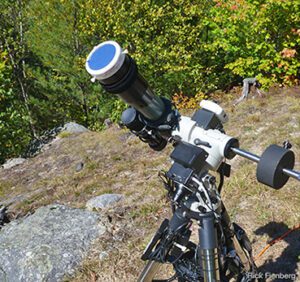COUNTDOWN TO TOTALITY* 22.07.28
Day(s)
:
Hour(s)
:
Minute(s)
:
Second(s)
Solar Filters for Optics -Telescopes, Binoculars & Cameras
As noted in the section How to View a Solar Eclipse Safely, with one notable exception it is never safe to look directly at the Sun through a telescope, binoculars, or camera lens without a solar filter.
That exception is during totality, when the dazzlingly bright solar surface is completely blocked by the Moon.
But totality is fleeting. Most of the time during an eclipse you’ll be watching the partial phases, during which filters are always required.
Solar Filters for Optics: Telescopes, Binoculars & Cameras
Telescopes, binoculars, and cameras need solar filters for two reasons: to protect them from intense sunlight and to ensure that you don’t accidentally look at the Sun through an unfiltered instrument. In every case, the solar filter must be attached to the front of your telescope, binoculars, or camera lens. This ensures that the Sun’s light and heat are kept out of the optics.
Make sure the filter is attached securely so it won’t pop off if your instrument is bumped or the wind suddenly gusts — but not so securely that you can’t remove it easily at the beginning of totality!
If your telescope has a small auxiliary finderscope or other aiming device, make sure that it is capped, removed, or safely filtered just like the main telescope.
Solar filters provided with inexpensive telescopes, usually designed to thread into an eyepiece at the back end of the telescope, are dangerous. If the filter is attached to the spot where you place your eye, sunlight concentrated by your optics will burn right though it.
This is also why looking through unfiltered optics while wearing eclipse viewers is extremely dangerous and a recipe for serious eye injury. We’ll say it again: a solar filter must be attached to the front of your telescope, binoculars, or camera lens.
You’ll generally encounter three types of solar filters: metal on glass (usually the most durable and expensive), aluminized polyester film (frequently referred to as aluminized Mylar), and black polymer (sometimes with a layer of aluminized polyester on one side). Some render the Sun white, while others impart a yellow, orange, or bluish tint. All are effective, so choose the type that best suits your preference and budget.
It is recommended that you should not attempt observing or photographing with a filtered telescope unless you have prior experience with this, are using your own equipment, and can remain with your equipment at all times to supervise its use.



